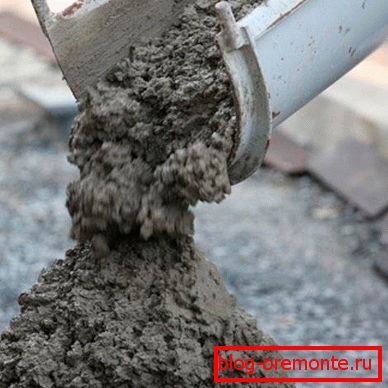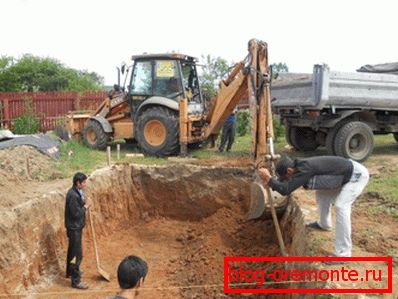Concrete pools - digging of the pit, backfilling of the
Many of those who live in the private sector or have dacha plots dream of creating an artificial reservoir, but believe that this construction is too expensive and time consuming. But if you set a goal and carefully carry out all the recommendations, then the work can be done independently, although this in fact takes a lot of manpower and resources. We will consider concrete pools, as this option will cost the least and will not require the involvement of specialists and construction equipment.

Why concrete
Consider why the construction of concrete pools is the most popular option. To better understand the issue, you should consider the main advantages and disadvantages of concrete structures.
| Virtues | disadvantages |
| Monolithic construction is much more durable than prefabricated versions. | As already noted, work on preparing the pit and pouring the foundation will require a lot of labor. |
| Despite the fairly large amount of work and materials, the price of this solution is much lower than when purchasing composite options. | The concrete bowl of the pool requires constant care and attention, otherwise mold will begin to form on the walls. |
| After hardening, the concrete surface can be finished almost as desired: it is lined with tiles or mosaics, covered with decorative protective composition, polyurethane compositions or covered with a special film. | All work must be carried out in accordance with the technology: it is necessary to observe the proportions of the components, and the preparation of the adhesive composition during lining should be carried out as required by the instructions on the packaging. |
| In terms of strength and durability, concrete is significantly superior to other analogues. Properly filled design is able to serve for decades. | If the drainage system is not properly designed and installed, the rework will take a lot of time and will require reworking of the whole structure, which is very costly. |
| This type of pool can be built both outside and inside. | Any disruption to the process and the use of poor quality materials lead to cracks and leaks. |
To build a concrete pool with your own hands, you must have at least minimal skills in the construction industry. A person inexperienced to make such a construction is hardly under the force, so at least one of those involved in the work must be well versed in concrete work.

Of course, very often the question arises, which pool is better - concrete or composite? It all depends on your preferences and financial capabilities, the composite eliminates the time-consuming work on pouring the solution, but the cost of this option is disproportionately higher.
The main stages of work
To understand this process in more detail, we will break it down into stages and consider them in more detail. It is important to remember that each type of work is very important, and violations at any stage can have the most negative consequences.
Preparatory stage
Like any other process, the device pool requires careful preparation, in which it is necessary to carry out the following activities:
- First of all, planning is carried out: you need to decide where the structure will be located and what its dimensions will be. It is important to bear in mind that as the size increases, the amount of work also increases, so it is not worthwhile to plan a huge structure, since the work on its construction can be overwhelming for you.

- Next is another important stage - planning the location of communications, it is important to clearly know in advance how the water will be supplied and where the drain hole will be located. There are cases when work on laying communications takes almost most of the time, and this is all because of illiterate planning.

- After all the necessary planning work has been completed, you can proceed to the calculation of the required amount of materials. Naturally, there should always be a reserve, since it is not known how accurate the calculations were, and what the actual thickness of the concrete layer would be, because every extra centimeter is an increase in the consumption of concrete.
- When determining the depth should be borne in mind that the minimum depth at which it is comfortable for an adult to swim is one and a half meters, and this value should be guided. In addition, the device requires a drainage layer, so the pit should be 40-50 centimeters more in depth as well as in width and length.
Tip! You can make protrusions on one or two sides, so that they are located 30-40 centimeters below the water level, they can be used as seats, which greatly increases convenience.

Digging and backfill drainage layer
When the location is determined, and all the marking work is completed, you can proceed to the construction of the pit, the work should be carried out in accordance with the following recommendations:
- With a large pool, it is best to use the services of an excavator, in other cases you can do it yourself, it’s certainly hard, but quite doable on your own. Another important note: even if you dig an excavator, finishing work and alignment will still have to be done manually.

- So that the walls do not crumble, they must be done with a slight slope (about 5-7 degrees). This is very important, as sliding layers of soil can put an end to your work.
- When the pit is ready, you can proceed to the device drainage pillows. It is made of sand and rubble as follows: first, 15-20 centimeters of sand are poured and leveled, after which medium or fine fractional gravel is filled with the same layer. After that, the surface must be leveled and tamped using tamping or improvised means.

- The last type of work that should be done is the laying of roofing material in 2-3 layers, while it is laid with an overlap on the vertical walls of 20-30 centimeters.
Concrete works
The main factor is the composition of the concrete for the pool, its brand should not be lower than M400.
Preparation of the solution is as follows:
- It is necessary to take high-quality construction sand without impregnations of soil and silt, crushed stone of middle fractions and cement of mark M500, it is desirable that it was made no more than 3 months ago.
- To make high-quality concrete for the pool, you must first mix sand with cement in the proportion of 3 parts of sand to one part of cement. After the water is added to obtain a mass, the consistency of sour cream, and in the last turn is added 5 parts of rubble. Also a reasonable solution would be to use an additive that increases the resistance of concrete to moisture.

- Do not forget that you need high-quality reinforcement, it is carried out by reinforcement with a thickness of 10-12 mm, the elements are tied with wire, and the ends of the rods along the perimeter are bent upwards for subsequent linking with the vertical armor.
- Then you can start pouring the base, do not forget that at the bottom there should be a slight bias towards the drain hole.
- After that, you need to wait 6-8 days until the concrete gains strengthIf the air temperature is high, the surface must be wetted twice a day.
Tip! In order not to lose time while the concrete hardens, you can do the laying of all necessary communications: bring water, make a drain in the cesspool.
- Next, a vertical formwork is installed, a reinforcing belt is laid down and a fill is made.. After the concrete hardens, the formwork is removed, the joints are additionally trimmed, although it is better to treat the entire surface with a waterproofing compound.
- The last stage - decorative trimit is no different from ordinary facing works.

The main thing to remember is that the concrete grade for the pool should not be lower than M400. If you need to cut reinforced concrete with diamond circles or diamond drilling holes in concrete, then all joints and joints must be carefully insulated with special compounds or mastics.
Conclusion
The video in this article will vividly show some features of the work process. Concrete pools were and remain the most popular option to create an artificial reservoir in the garden or summer cottage.